My obsession with Panda Express’s Chow Mein began when I was looking for an inexpensive lunch near work. What started as an occasional treat quickly became a twice-weekly habit, seriously cutting into my budget. I knew I had to learn how to make this perfect side dish at home or risk watching my lunch expenses spiral out of control!
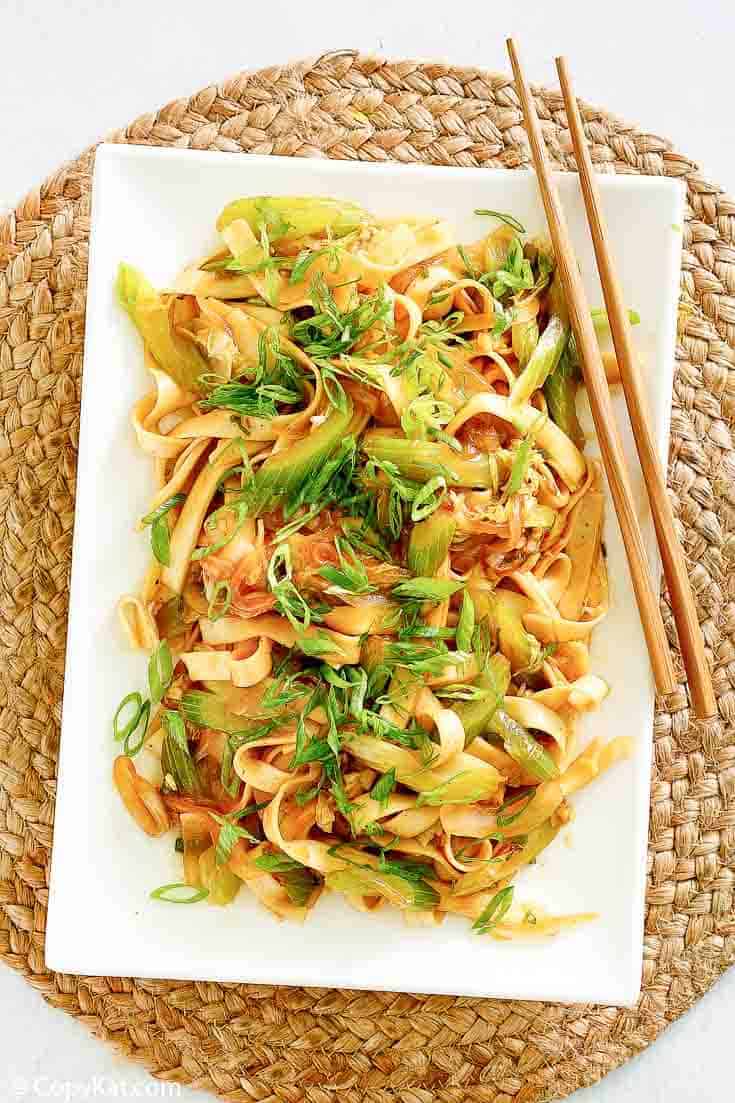
This post contains affiliate links. As an Amazon Associate, I earn from qualifying purchases.
Table of Contents
Recreating the authentic taste of Panda Express Chow Mein at home
After watching countless cooking videos and experimenting with different ingredient combinations, I finally had my eureka moment. The secret wasn’t just in the ingredients but in the technique and the specific type of noodles. That first successful batch tasted even better than the restaurant version, and my friends couldn’t believe I’d made it myself. Now, I’m passing this hard-won knowledge on to you so you can enjoy restaurant-quality chow mein without leaving your kitchen.
What Makes This Chow Mein Recipe Special
This copycat Panda Express Chow Mein recipe stands out because it perfectly recreates the restaurant’s signature balance of flavors and textures. Unlike other versions you might find online, this recipe doesn’t rely on an overly sweet or thick sauce or add ingredients that aren’t in the original.
The magic lies in the authentic combination of oyster sauce, hoisin sauce, sesame oil, and the proper cooking technique. When prepared correctly, these noodles have that perfect slightly chewy texture with crispy edges and vegetables that remain fresh and cris, but fresher and more customizable to your taste preferences.
Panda Express Chow Mein Ingredients
Here’s a list of what you need to make this chow mein recipe:
- Lo mein or yakisoba noodles – Form the foundation of the dish; provide the characteristic chewy texture with slight springiness due to alkaline elements in the noodles
- Soy sauce – Delivers the primary salty umami flavor base and adds rich amber color to the noodles
- Sugar – Balances the saltiness with a touch of sweetness that helps create the classic flavor profile
- Cooking wine – Adds depth and complexity while helping to tenderize the noodles and vegetables
- Oyster sauce – Contributes a distinct savory richness that’s essential for authentic Chinese flavor; adds slight sweetness and thickness
- Hoisin sauce – Provides a complex sweet-salty bean flavor with aromatic notes that enhance the overall depth
- Fresh garlic – Infuses the dish with aromatic pungency that creates a foundation of flavor
- Fresh ginger – Adds a spicy warmth and distinctive aroma that’s characteristic of Asian cuisine
- Green onions – Contributes mild onion flavor and fresh color as both ingredient and garnish
- Sesame oil – Imparts a distinctive nutty aroma and flavor that’s characteristic of authentic Chinese cooking
- Cooking oil – Creates the high-heat cooking environment needed for proper stir-frying technique
- Napa cabbage – Provides a crisp texture and mild sweetness that absorbs the sauce beautifully
- White onion – Adds aromatic sweetness and slight crunch that enhances the overall texture
- Celery – Cont
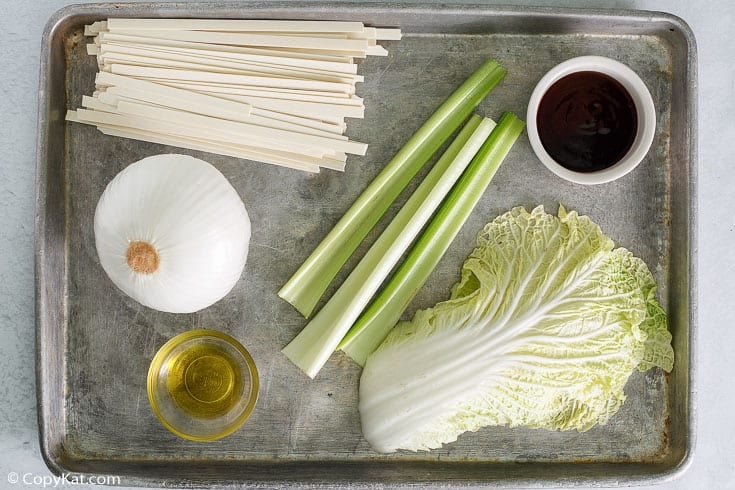
Ingredient notes
This dish has a lovely Asian sauce. The ingredients to make the sauce are available at your local grocery store. Any store with a tiny Asian section will have these ingredients. This recipe makes a delicious lo mein sauce you will love in any stir fry recipe.
Two must-have ingredients for chow mein sauce
Two less commonly known ingredients in the chow mein sauce recipe are oyster sauce and hoisin sauce.
- Oyster sauce is a slightly sweeter version of soy sauce, and it does contain oysters. An excellent vegetarian substitute is mushroom-based soy sauce.
- Hoisin sauce is a thick and salty, bean-based sauce. It adds a unique flavor to chow mein, but in a pinch, you can substitute teriyaki sauce.
Both oyster and hoisin sauce are very popular sauces available from major brands like La Choy.
How to make chow mein
Besides the proper ingredients, great chow mein requires knowing how to stir fry correctly. The good news is that you don’t need a wok, but a heavy-bottom pan is necessary. A large cast-iron or steel skillet will help to retain and distribute heat evenly. So, even if you don’t have a wok, use a large, heavy skillet.
The secret to a great stir fry is high heat and not overcrowding the pan unless you want to wind up with steamed noodles. Depending on how much you are cooking and your pan’s size, you may have to stir fry in batches.
- In a small bowl, whisk together soy sauce, sugar, cooking wine, oyster sauce, hoisin sauce, garlic, ginger, green onions, and sesame oil.
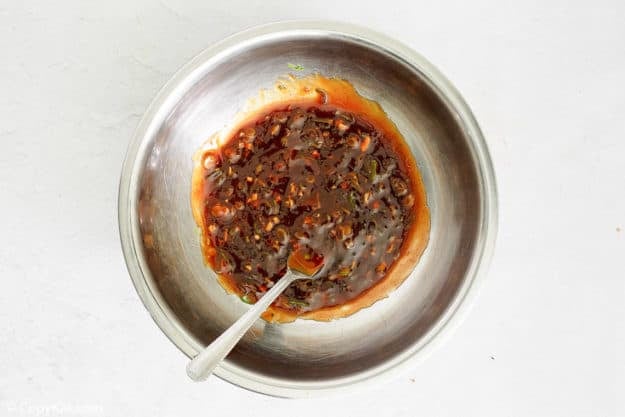
- Prepare noodles according to package directions. When noodles are done, drain them.
- Chop cabbage and slice the onion and celery.
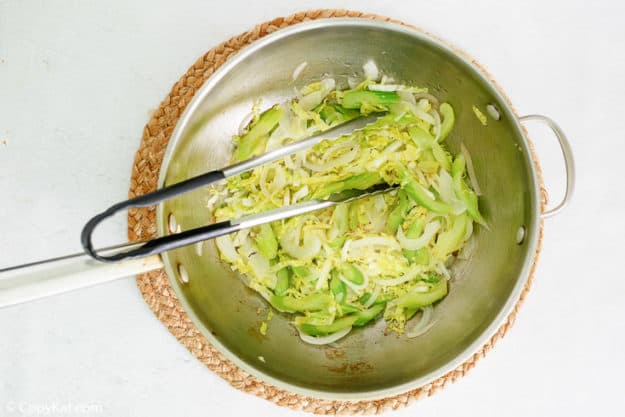
- Heat cooking oil in a wok or large skillet over medium-high heat.
- Add onion and celery, and cook, stirring often, until tender.
- Stir in cabbage until heated through.
- Add noodles and 1/2 cup of sauce. Stir until well combined and the noodles are heated through.
- Serve immediately.
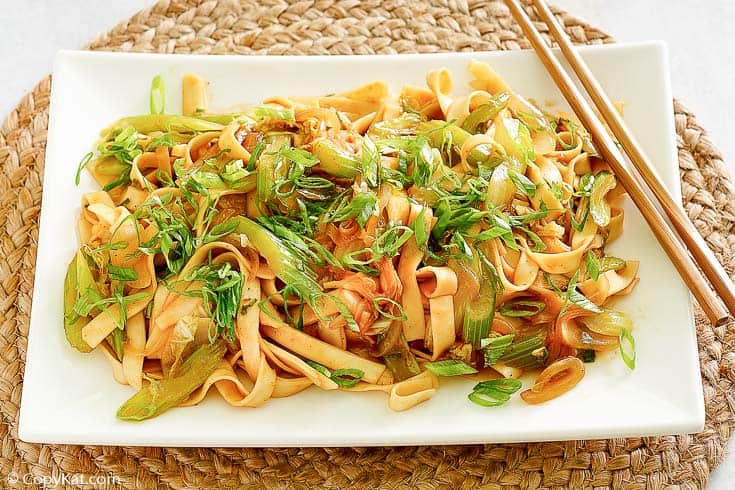
Tips for Panda Express noodles
- Use an oil with a high smoke point. Neutral oils such as canola or grapeseed oil are good choices because they won’t impart any unwanted flavors to the dish. You can use slightly less oil if you want, but watch out for sticking.
- Serve it with style. Garnish with sliced scallion and sesame seeds for a restaurant-quality presentation
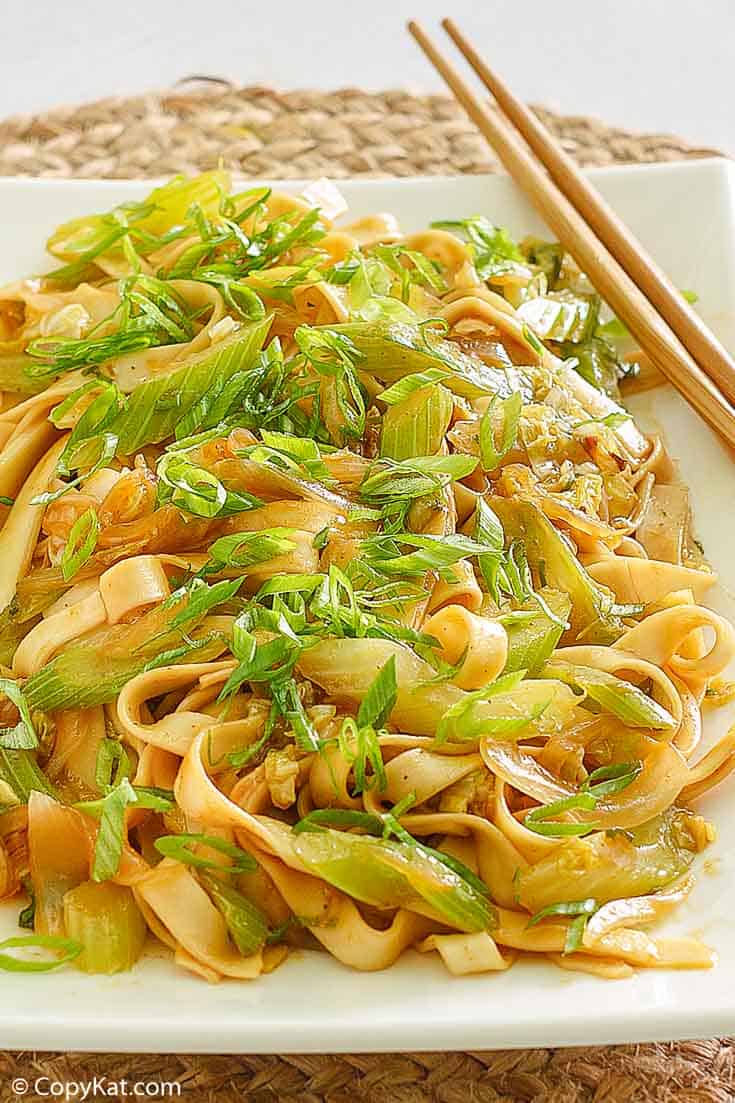
What to serve with this chow mein Panda Express recipe
Chinese people eat chow mein as an alternative to white rice and not as the main course. While you can make a meal of it, it is nice to have a variety of dishes to enjoy. You can’t go wrong by pairing this dish with other Asian favorites, including:
But don’t feel like you can’t serve chow mien with other types of cuisine as well. Have fun and experiment. The following dishes are a good jumping-off point:
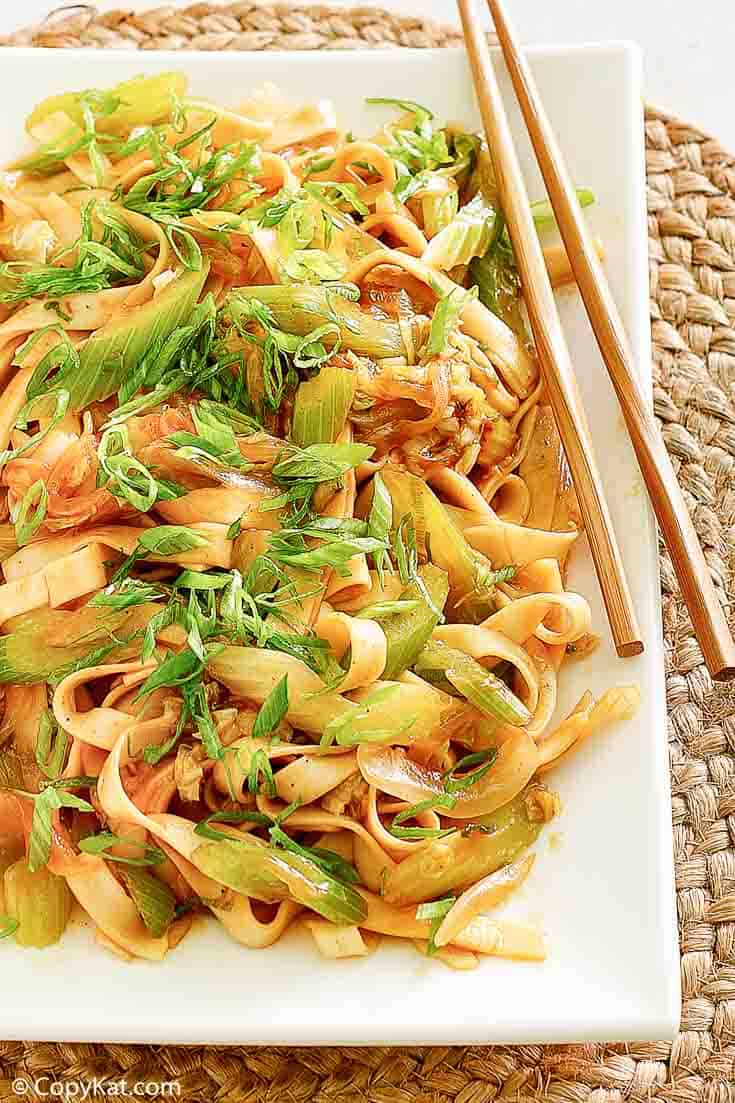
Panda Express Chow Mein
Ingredients
Lo Mein Sauce
- 1/2 cup soy sauce
- 1/4 cup sugar
- 2 tablespoons cooking wine
- 2 tablespoons oyster sauce
- 1 tablespoon hoisin sauce
- 1 garlic clove chopped
- 2 teaspoons fresh ginger minced
- 2 tablespoons green onions minced
- 1/4 teaspoon sesame oil
Chow Mein Ingredients
- 14 ounces lo mein noodles or 2 packages of Yakisoba noodles (dry) prepared without seasoning packages
- 2 tablespoons cooking oil (use vegetable, olive oil, or oil of your choice)
- 2 cups napa cabbage sliced
- 1 large sliced white onion
- 3 celery stalks cut diagonally into 1/4 inch slices
Instructions
- In a small bowl, whisk together soy sauce, sugar, cooking wine, oyster sauce, hoisin sauce, garlic, ginger, green onions, and sesame oil; set aside.
- Prepare lo mein noodles by placing them in large pot of boiling water. Cook according to package directions. When noodles are done, drain and rinse them.
- Heat 2 tablespoons of oil in a wok or large skillet over medium-high heat. Add onion and celery, and cook, stirring often, until tender, about 3-4 minutes, the onions will begin to become translucent.
- Stir in cabbage until heated through, about 1 minute. Add noodles, and 1/2 cup of sauce, toss until well combined and the noodles are heated for about 2 minutes.
- Serve immediately.
Video
Nutrition
Love Asian food? Try these recipes!
- Copycat PF Changs Lettuce Wraps
- Chinese Spare Ribs Recipes
- Crab Casserole
- Homemade General Tso
- Hunan Crispy Chicken
- Egg Foo Young
- Homemade Tempura Batter
- Chicken Katsu
- Chinese Sweet Donut
- Chinese Buffet Cookies
Most Popular Panda Express Copycat Recipes
Be sure to take a look at more of my easy recipes for Chinese food and the best copycat fast food recipes.
To keep up with all of our new recipes, be sure to follow us on Facebook.
Ingredient Substitutions
- Noodle alternatives: If you absolutely cannot find lo mein or yakisoba noodles, try thin wheat noodles labeled as “Chinese egg noodles” or even ramen noodles (discard the seasoning packet).
- Cabbage options: Regular green cabbage can replace napa cabbage, though the texture will be slightly different.
- Vegetarian adaptation: Use vegetarian oyster sauce (usually mushroom-based) to make this dish completely vegetarian.
- Cooking wine substitutes: Dry sherry makes an excellent substitute for Chinese cooking wine. For a non-alcoholic option, try using broth with a splash of rice vinegar.
- Oil options: Any high smoke point oil works well—canola, vegetable, peanut, or even avocado oil.
Protein Additions
Transform this side dish into a complete meal by adding:
- Chicken: Thinly sliced chicken breast, stir-fried first and set aside before adding back with the noodles
- Beef: Thinly sliced flank steak or sirloin, marinated briefly in soy sauce and cornstarch
- Shrimp: Peeled and deveined, added just before the noodles as they cook quickly
- Tofu: Extra-firm tofu, pressed, cubed, and pan-fried separately before adding to the dish
Vegetable Variations
Feel free to incorporate additional vegetables such as:
- Shredded carrots for color and sweetness
- Bean sprouts for extra crunch
- Thinly sliced bell peppers for color and flavor
- Snow peas or snap peas for fresh sweetness
- Broccoli florets blanched slightly before adding to the stir-fry
Storage and Reheating Instructions
Refrigeration
- Cool completely before storing in an airtight container.
- Refrigerate for up to 5 days.
- Separate storage: If making ahead, consider storing the sauce separately from the cooked noodles and vegetables to prevent sogginess.
Freezing (Not Recommended)
Freezing is not recommended for homemade chow mein as the texture of the vegetables and noodles significantly deteriorates upon thawing.
Reheating Methods
- Stovetop (best method): Reheat in a hot skillet or wok with a small amount of oil, tossing frequently until heated through. This restores some of the original texture.
- Microwave: For convenience, microwave in 30-second intervals, stirring between each interval. Add a sprinkle of water if the noodles seem dry.
- Revitalizing tip: When reheating, add a small drizzle of soy sauce and sesame oil, along with some fresh green onions, to refresh the flavors.
Why You’ll Love This Recipe
Making Panda Express Chow Mein at home allows you to customize your favorite side dish exactly how you like it. Want it a little spicier? Add some red pepper flakes. Prefer more vegetables? Double them up! The possibilities are endless.
Beyond customization, homemade chow mein tastes fresher and more vibrant than takeout. The vegetables maintain their crispness and color, and you can adjust the sauce to your preference. Plus, there’s something incredibly satisfying about creating restaurant-quality Chinese food in your kitchen.
Best of all, this recipe is remarkably economical. What costs $3-4 as a side dish at Panda Express can feed a family of four for roughly the same price when made at home. Master this recipe, and you’ll have an impressive, versatile dish that works as both a side and a main course in your cooking repertoire.









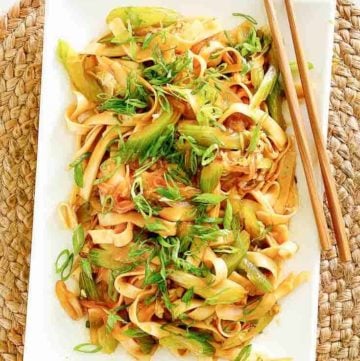
I thought this was pretty good!
Fried noodles are quite attractive. look very delicious. I appreciate your cooking skills.
Panda Express says their chow me in is vegetarian. Do you think they use oyster sauce?? Is it really necessary? What is a good substitute for it? My family loves it, so I’d love to try to make it at home. Thanks for this!!
Maybe you can use some fermented black beans, I think there is a something that is missing without the oyster sauce.
The chow mein isn’t vegetarian. The basic sauce used contains a meat base. There isn’t oyster sauce. Just salad oil, soy sauce and shoaxing cooking wine.
Thank you for making this clear.
Wow… I love❤❤❤. I can’t wait to try this out. #Foodie
What is the recipe for the chow mien noodles
I love your recipes – but the site is so loaded with ads it’s very hard to scroll through.
I found that you can click off the are which makes for easier scrolling. Hope this helps.
This is very good; but both times I’ve made it, the noodles are soggy (which is odd, because I usually have to cook noodles a minute extra) Next time, I will boil them a minute or two less- especially beings they cook for a couple minutes as a whole dish at the end.
I don’t have hoisin sauce, cooking wine, or sesame oil. So, I either omit the hoisin or use more oyster sauce, use beef broth in place of the wine, and use vegetable oil in place of the sesame oil.
Lastly, the most recent time I made this, I only made half a batch, which was enough for the 5 of us with leftovers.
Just wanted to give ya a pointer. If u find u have cooked them too much n they are a bit mushy, rinse ur noodles off in cold water. This will remove the starch from ur noodles and make them have a more firm texture. I do this with all my pasta salads 🙂 Hope this helps
Sooo. .. where’s the recipe???????
do you have the resipes Kung Pao from Panda express?
I have the beef and broccoli, and the cheese puffs. More to come later.
Hey Stephanie! If u get a chance to work on the Beijing Beef, that would be great!! I cant quite figure out a breading for it. Thanks 🙂
my family loves this recipe and appears on our table at least once a week. Keep up the good work Stephanie, I have enjoyed many of your posted recipes
Stephanie, it was delicious! You never said what to do with the other 1/2 of the sauce, so I used it all!
Thats what I am wondering, as I write this down lol
I don’t like Panda Express’s chow mein at all but I love their black pepper chicken. Any chance you have the recipe for that? Thanks!
I do not have that recipe now 😉 I appreciate the suggestion.
this is on my menu for this week, looks easy and I LOVE Panda Express chow mein!
I hope you enjoy the recipe.
This looks incredible! I’m a sucker for a great chow mein!
Thank you very much.
I love this stuff… thank you! Pinned.
Thank you for the pin!
Thank you for taking the time to do all this!!
Thank you for stopping by!
Hi Stephanie, i love watching your youtube videos, i recreate most of the vegetarian dishes in my kitchen and my family loves all the recipes as they taste just like what we get at restaurants. Can you put a recipe for Vegetarian Lumpia, a Phillipino dish.
I will see what I can do.
Omg so amazing!!!!!
Thank you!
In past I have added 2 1/2 cups of cook chopped chicken when the cabbage was put in the wok. We always seem to have extra chicken available and this works very well in this recipe for us.
Your addition of chicken would turn this into a complete meal.
Stephanie, you mention oyster sauce and hoisin in your text but not in the ingredient list. how much and when do we add it?
Thanks for noticing. I have added in there.